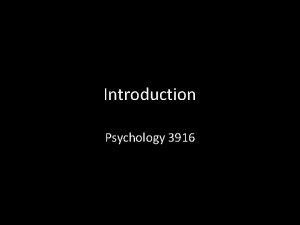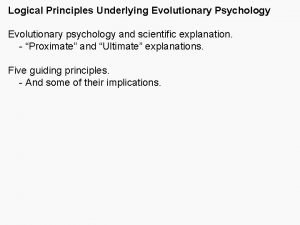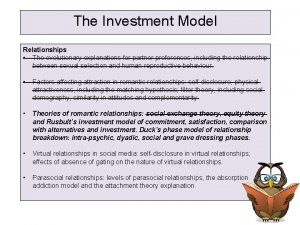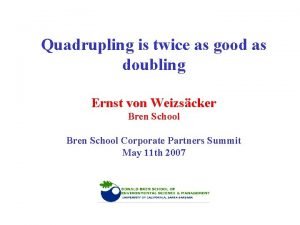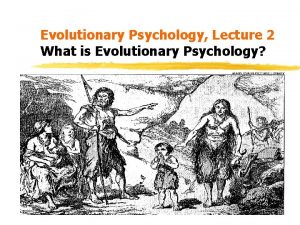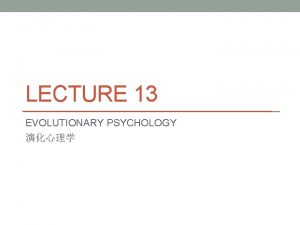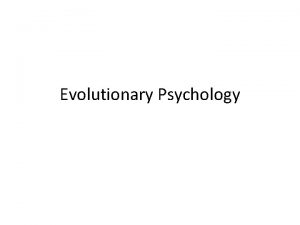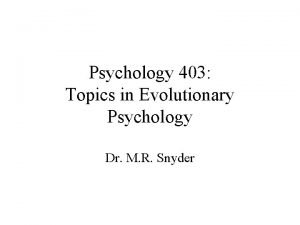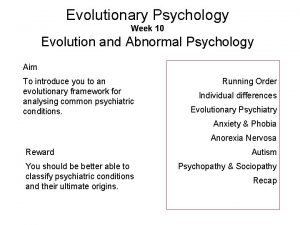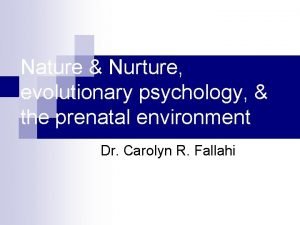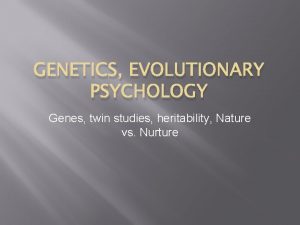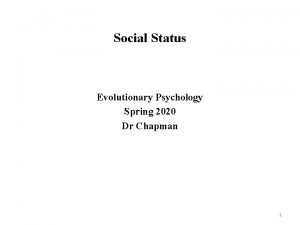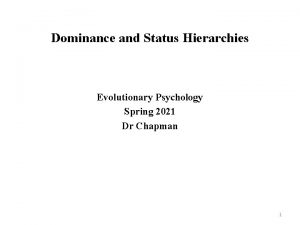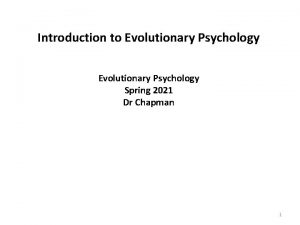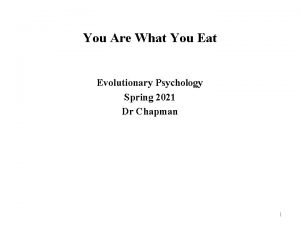The Nature of Human Nature Evolutionary Psychology Spring





















- Slides: 21

The Nature of Human Nature Evolutionary Psychology Spring 2020 Dr Chapman

Features of Evolutionary Psychology • A scientific synthesis of modern evolutionary biology and modern psychology • Discover previously unsuspected links between our biology and behavior • Grammar (1996) singles bar study • Focus on adaptive function provides inspiration for new research • Goal of mapping the universal human nature • A comprehensive reconstruction of the social sciences – Correct the Standard Social Science Model (SSSM) • the mind is blank-slate-like – Are predominantly general purpose learning and reasoning mechanisms • To understand the “human nature” of the social interactions between the sexes both evolved psychological mechanisms and culture are required

Three theories of the origins of complex adaptive mechanisms • Origin theories – Creationism (intelligent design) is not a scientific theory • cannot be tested • does not guide researchers to any new scientific discoveries • has not proved useful as a scientific explanation – Seeding • testable principle – currently no scientific evidence of seeding – has not led to a new scientific discoveries – cannot explain scientific puzzles – Evolution by natural selection • principles have been confirmed many times and never disconfirmed

Three Products of Evolution (See Table 2. 1) • Adaptations are traits that help living organisms survive and reproduce in a particular environment. • By-Products are secondary or incidental traits that can be useful or may have no benefit. • Noise (random effects) produce changes in traits but are not selected

Noise or Random Effects • Noise or Random effects – result in changes in a phenotypic trait – But are not selected for or connected to an adaptive trait • Noise – Mutations are the ultimate source of genetic variation • Neutral (are most common, Buss page 35 is incorrect) – See Genetic Mutations – Do not increase or decrease survival or reproduction • Noise i. e. additional variation in biological systems – anatomy of brain circuits for color vision • Random effects – Sudden large changes in the environment – Accidents during development such as lack of nutrition or lack of experience that is needed for normal development.

By-Products • Phenotypic traits that do not "currently" solve adaptive problem • They are carried along by adaptive traits so: – they were not selected for – do not have a functional design • Examples: – Belly Button is a by-product of placental birth – Red color of blood is a by-product of hemoglobin – High rates of abuse by stepparents is a by-product of a lack of parental solicitude.

Adaptations • Examples of adaptations – Morphological • drug resistance in bacteria • shape of a Finch's beaks • mane on a male lion – Behavioral • moving in large groups • retreat to shady locations during the hottest hours • aggression towards competitors – Cognitive/Emotional • perception of color • fear of snakes • language

Clarifying Adaptation and Natural Selection - 1 • George C. Williams (1926 – 2010) • Individual Selection – is selection for traits that would be beneficial to an individual. • Group Selection – is selection for traits that would be beneficial to a population at the expense of the individual possessing the trait. – An evolutionary process involving differential survival and reproduction of competing groups. • Adaptations – are the structures or behaviors of an organism that are suited to a particular environment. – the process of change to better conform with environmental conditions. • Adaptations are problem solving devices • They are the only known causal process by which complex, functional design can come to exist. • Evolved fear adaptations: Snakes and spiders, for example, signal potentially dangerous threats to survival.

Clarifying Adaptation and Natural Selection - 2 • "Inherited and reliably developing characteristic that came into existence through natural selection because it helped to solve a problem of survival or reproduction during the period of its evolution" (Buss p. 34) – – Inherited: must have genes for the adaptations Develop reliably among species members in normal environments A product of natural or sexual selection The design of adaptations reflects their functional efficiency • economy: does not waste energy • precision: specific to adaptive problem • reliability: occurs in most individuals in a population

Environment of Evolutionary Adaptedness (EEA) • Was coined by John Bowlby of attachment theory fame • EEA does not refer to a specific time or place – could be relatively recent such as evolution of human language circuits – or across a very long time span such as the structures of the eye • Composite of selection pressures during the adaptation's period of evolution which can be millions of years – each adaptation has an EEA – EEA for language – EEA for sweet preference • Maladaptation Brady 2019, a mismatch – some adaptations, preference for sweet, evolved to solve adaptive problems of our ancestors – they may not solve the adaptive problems of contemporary industrial society such as an abundance of high calorie food

Definition of Evolved Psychological Mechanisms • Psychological Mechanisms are “psychological adaptations” constructed by natural selection over evolutionary time 1) 2) 3) 4) 5) 6) Form determined by solving a specific problem Specialized Information Processing Input identifies the adaptive problem Decision rules transform the input into an output Output can be physiological(emotional), behavioral and or cognitive Output is directed toward the solution to the adaptive problem • Evolved Psychological Mechanisms 10 illustrations • Example of a Psychological Mechanism – Fear of snakes article by Vanessa Lo. Bue and Judy S. De. Loache – A snake like object on the ground, identify the object as a snake, respond with fear, move away, appraise situation – “Snake” Sensory Perceptual Processing Decision Output – Snake slithering through the grass You Tube video

Important Properties of Evolved Psychological Mechanisms • Non-arbitrary criteria for identification and description of psychological mechanisms is derived from their function. – Function determines form so identifying function can help understand the form. – "Carving the Mind at It's Joints" – "Dividing the Mind by Its Functions" such as • Respiration • Fear response • Language production • Psychological mechanisms tend to be problem specific – – adaptive problems are specific and require a specific mechanism to solve them "no such thing as a general adaptive problem" relatively easy to do for other body parts such as liver, heart, hand, eyes dividing up the mind based on psychological functions is much more difficult • Can be based in brain circuits up to a point • Some brain circuit are used in multiple functions • Brain circuits interact with each other

Beyond Domain-Specific Psychological Mechanisms • Domain-specific psychological mechanisms solves specific problem of survival or reproduction that was recurrent in the EEA. – Humans Possess many specific Evolved Psychological Mechanisms: – Numerous psychological mechanisms produces behavioral flexibility • Each specific function, decision rules, adds flexibility • Domain-general psychological mechanisms are aimed at solving complex, novel problems – Solving problems using rationality – Evolution of General Intelligence • useful in solving novel problems • better at attaining goals in unfamiliar or changing conditions • coping with social complexity – Superordinate psychological mechanisms that regulate or coordinate a large number of other psychological mechanisms – General mechanisms of learning examples • Associative conditioning in classical conditioning • Role of reinforcement in instrumental conditioning

Brain circuits as Psychological Mechanisms • Brain circuits are phenotypic traits – a brain circuit is a physical system • selected to process information, store information and generate behavior • retinal circuits for Color vision • Brain circuits were designed by natural selection to solve problems such as – hunting and gathering – avoiding predators – finding a mate • Brain circuits develop reliably in most individual under normal environments

Learning, Culture and Evolved Psychological Mechanisms • Nature vs Nurture Confusion – Nature (genes) produce predispositions – Nurture (experience) refers mainly to the care given to children although any environmental experience also would count as "nurture". • Blank Slate "Tabula Rasa" is the notion that humans are born "blank" (with no built-in mental content), and that their identity is defined entirely by events after birth. • Interaction of Nature (genes) and Nurture (experience) – Genes produce the basic structure of brain circuits prenatally – Experience changes brain circuits postnatally – genes do not code for individual phenotypic traits • Genes code for Proteins which make up the structure and biochemistry of Neurons which are organized into Circuits • Circuits are part of Systems (sensory, motor, emotional, motivational) – Psychological mechanisms • Systems process information and produce behavior and or cognition

Learning, Culture and Evolved Psychological Mechanisms • Organization of all of these brain circuits is influenced by selection – They make up a unique set of "species-typical" information processing and behavior that is "human nature" • Culture is an important part of human nature – Psychological mechanisms evolved in ancestral social environments that produced group-level phenomena such as cultural traditions • culture information is used by humans for survival and reproduction – which includes tools, norms, values and institutions • specialized brain circuits related to culture for – imitating others, theory of mind i. e. "mind reading“, generating norms and values – Culture on the other hand is part of the environment has selection pressure on psychological mechanisms to deal with supra-individual phenomena

Is There a Human Nature? • “Nature: the inherent character or basic constitution of a person or thing” from Merriam-Webster dictionary • All species have a nature, each molded by the evolutionary history of the species – a composite of the physical characteristics, behavior and environment they occupy • A lion nature • A wolf nature • A chimpanzee nature • Humans should not be separated from nature – humans are animals so humans are part of nature – because humans produce cultural artifacts such as tools or buildings • some would exclude us from nature because we have culture • however birds build nests and chimpanzees make tools – Actually, culture is part of human nature

Human Universals Evolutionary psychologists are identifying universal human nature, the evolved adaptations that collectively constitute universal human nature • Examples (do not need to know all these details, just a few examples) o – anatomical: bipedalism, hands, big frontal cortex – behavioral: aggression, gestures, gossip, and facial expressions – mentally: emotions, dichotomous thinking, wariness around or fear of snakes, empathy – language: grammar, phonemes, polysemy, metonymy, antonyms, frequency and length of words – social: division of labor, social groups, age grading, the family, kinship systems, ethnocentrism, play, exchange, cooperation, and reciprocity – cultural: myths, legends, body adornment, daily routines, rules, concepts of luck and precedent, use and production of tools

Human Universals • Kinds of (do not need to know these details) – absolute universals: found among all peoples known to ethnography and history – near universals: some few known exceptions such as fire making – conditional universals: if a particular condition is met, then the trait in question always accompanies it such as calluses – statistical universals: at a rate that seems well above chance such as words used for the pupil of the eye – universal pools: a limited set of options exhaust the possible variations such as kinship terminologies

Human Universals • Causes of cultural universal such as myths – the evolution of the human mind (brain circuits) – cultural reflects the physical necessity of survival – the diffusion of useful ancient cultural traits • Role of culture – culture should not be separated from nature – culture such as the invention of tools is a product of human nature – cultural information is part of the environment that individuals live in so it acts as a selection factor

Human Universals • Cultural and Individual variability – Concept of Humans Universal does not imply that every person in every culture will have identical behavior – Interaction of cultural and biological influences produces a range of outcomes – At a general level there are similarities in human behavior • Humans have a preference for sweet • However, the specific food eaten will vary across culture • Strength of the preference will vary across individual
 Evolutionary perspective of psychology
Evolutionary perspective of psychology 7 perspectives of psychology
7 perspectives of psychology Evolutionary perspective of psychology
Evolutionary perspective of psychology Evolutionary psychology questions
Evolutionary psychology questions Outline an evolutionary explanation for partner preferences
Outline an evolutionary explanation for partner preferences Class of 20
Class of 20 Kim ki duk spring summer fall winter
Kim ki duk spring summer fall winter What months are fall
What months are fall Spring nature
Spring nature Hát kết hợp bộ gõ cơ thể
Hát kết hợp bộ gõ cơ thể Lp html
Lp html Bổ thể
Bổ thể Tỉ lệ cơ thể trẻ em
Tỉ lệ cơ thể trẻ em Gấu đi như thế nào
Gấu đi như thế nào Tư thế worm breton là gì
Tư thế worm breton là gì Chúa yêu trần thế alleluia
Chúa yêu trần thế alleluia Các môn thể thao bắt đầu bằng tiếng đua
Các môn thể thao bắt đầu bằng tiếng đua Thế nào là hệ số cao nhất
Thế nào là hệ số cao nhất Các châu lục và đại dương trên thế giới
Các châu lục và đại dương trên thế giới Công thức tính thế năng
Công thức tính thế năng Trời xanh đây là của chúng ta thể thơ
Trời xanh đây là của chúng ta thể thơ Mật thư tọa độ 5x5
Mật thư tọa độ 5x5


